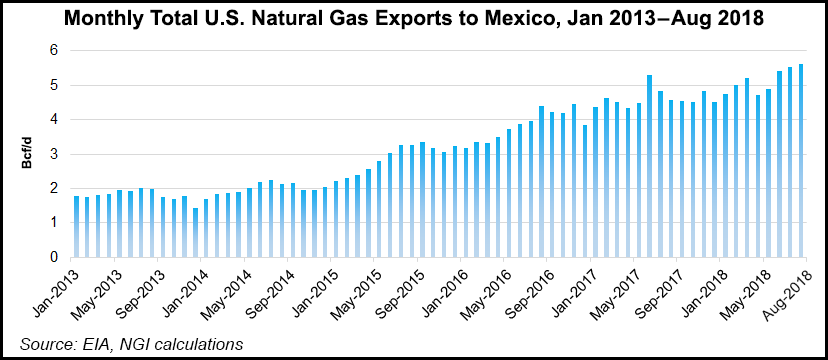Regulatory | Infrastructure | NGI All News Access | NGI The Weekly Gas Market Report
South Texas Natural Gas Line Expansion OK’d to Start Flowing into Mexico
FERC on Wednesday gave the green light for more natural gas flows into Mexico authorizing the in-service of Texas Eastern Transmission’s (Tetco) South Texas Expansion Project (STEP), which transforms its existing Line 16 system to bidirectional service.

The Federal Energy Regulatory Commission’s approval was based on its field inspection of the project site that was conducted earlier this month and on Tetco’s recent construction status report, which demonstrated that restoration of the disturbed areas is proceeding satisfactorily. Tetco must comply with all applicable remaining terms and conditions of the order.
Tetco first filed at FERC for the 400,000 Dth/d STEP in 2015, although approval didn’t come until this past February. The project included installing an 8,400 hp compressor unit, a meter and regulating station and appurtenant facilities on existing Tetco property in Nueces County, which is in South Texas.
It also included installing an 8,400 HP compressor unit, piping modifications, and appurtenant facilities at the existing Blessing Compressor Station in Matagorda County, TX, as well as modifying piping and other compression facilities at the Mont Belvieu Compressor Station in Chambers County, TX; Vidor Compressor Station in Orange County, TX; and Angleton Compressor Station in Brazoria County, TX.
Modifications were also made to piping at existing pig launcher and receiving sites along Tetco’s Line 16 in Brazoria, Chambers and Orange counties.
Mexico’s Comision Federal de Electricidad, the project’s anchor customer, previously subscribed for incremental service on a transportation path extending from points near the Texas-Louisiana border to the new delivery point at the Petronila Compressor Station site.

The added flows across the border come as Mexican pipeline exports have grown considerably following expansions of cross-border pipeline capacity. Exports to Mexico averaged 4.2 Bcf/d in 2017 and 4.4 Bcf/d through the first five months of this year, according to the Energy Information Administration (EIA).
Natural gas exports to Mexico by pipeline exceeded 5 Bcf/d for the first time in July 2018, after the commissioning of several key pipelines in Mexico, according to Genscape Inc. November month-to-date pipeline exports to Mexico have averaged 4.74 Bcf/d. “This was almost exactly in line with our October forecast for November flows of 4.77 Bcf/d,” Genscape senior natural gas analyst Rick Margolin told NGI.
For 2019, the firm is currently projecting exports to average 5.48 Bcf/d. “Please keep in mind, though, that number changes almost weekly based on performance and recalibration of the other Mexican supply/demand line items, as well as changes to expectations of timing around infrastructure,” Margolin said. Indeed, TransCanada Corp. earlier this month pushed back the targeted completion dates of its already delayed Tuxpan-Tula and Tula-Villa de Reyes pipeline projects.
Currently, about three-quarters of U.S. natural gas pipeline exports to Mexico flow from southern Texas, according to EIA. Exports from southern Texas averaged 3.2 Bcf/d in 2017 and 3.3 Bcf/d through the first five months of 2018.
“This natural gas is sourced primarily from the Eagle Ford basin in Texas and transported on an existing pipeline network to serve industrial and power sector customers in northeastern Mexico,” EIA said.
© 2024 Natural Gas Intelligence. All rights reserved.
ISSN © 1532-1231 | ISSN © 2577-9877 | ISSN © 1532-1266 |
